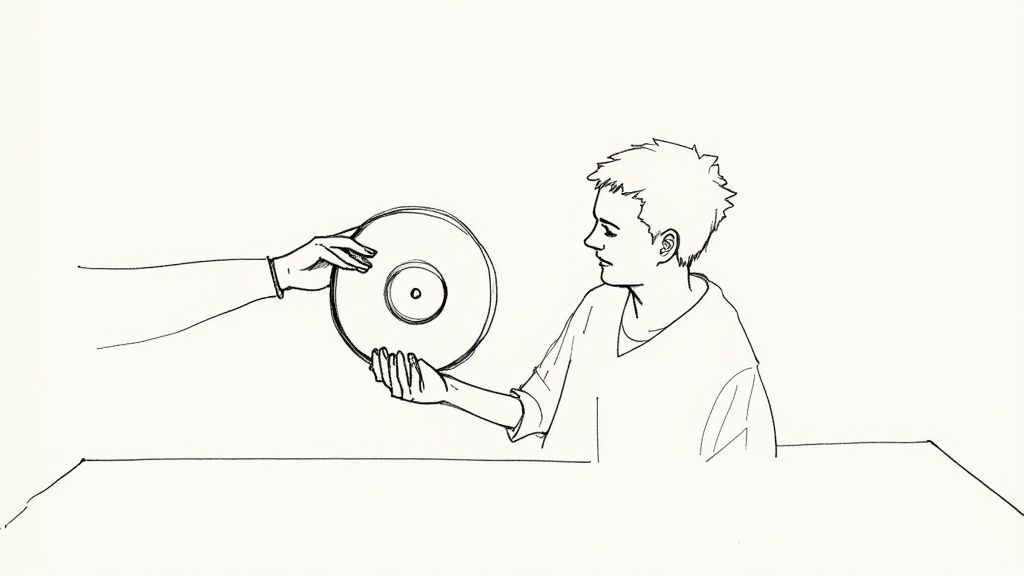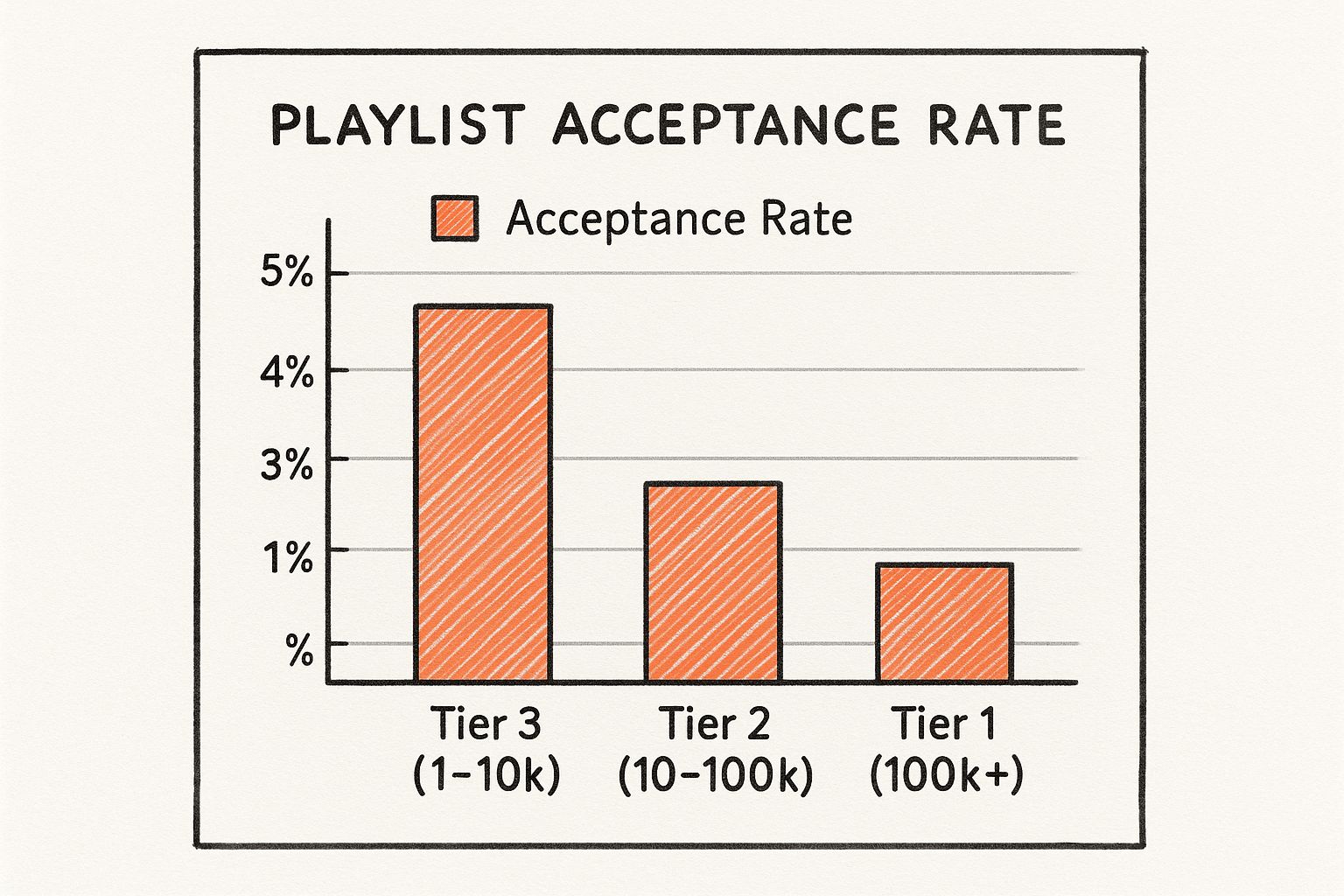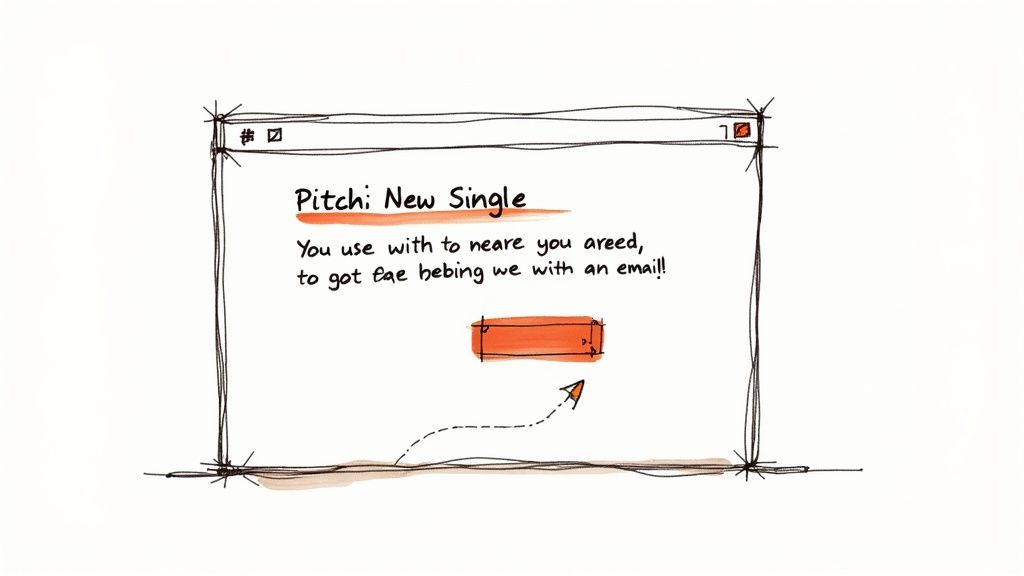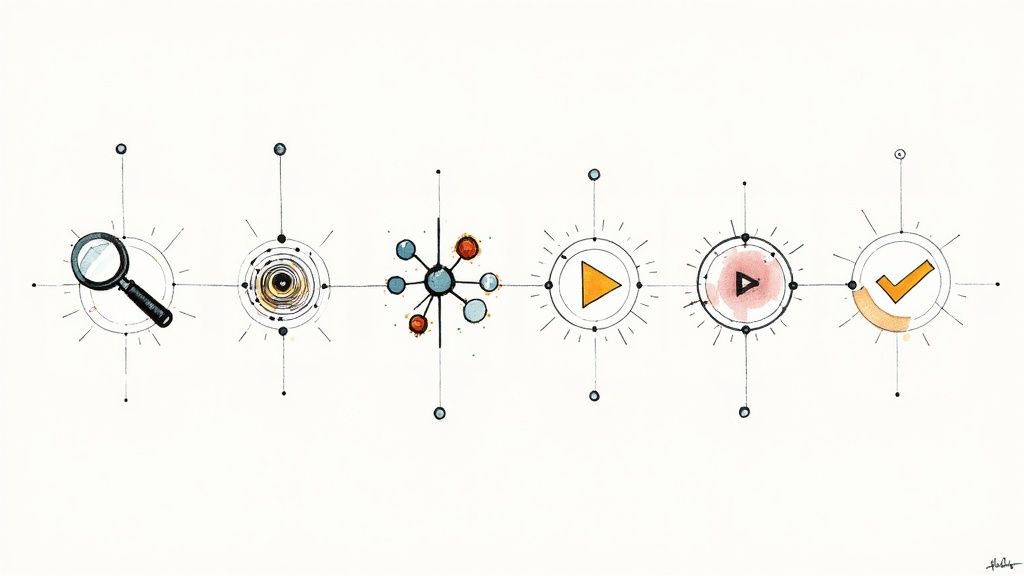A Modern Guide to Spotify Playlist Pitching
- fopexe3864
- Jul 22
- 13 min read
Successful Spotify playlist pitching doesn't start with an email. It actually begins long before you even think about hitting 'send'. It’s all about building a professional foundation that screams "serious artist" to any curator who glances your way.
Think of it as setting the stage. You need to optimize your entire online presence to make an immediate, positive impression on the industry gatekeepers who can change your career.
Building Your Foundation for a Winning Pitch

Before a curator ever listens to your track, I guarantee they'll take a quick look at your Spotify artist profile. It's your digital resumé. A sparse or unprofessional profile is an instant red flag, signaling that you might not be ready for a major playlist feature.
Your goal is to present a cohesive and compelling artist brand. This isn't just about having amazing music; it's about showing your commitment and professionalism. Curators are absolutely swamped with submissions, and they use these foundational elements as quick filters to separate the dedicated artists from the hobbyists.
Your Pre-Pitch Professionalism Checklist
Start by doing an honest audit of your digital footprint. Every single element should look intentional and align with the story your music is trying to tell. A strong first impression can dramatically boost your pitch's chances of getting noticed.
Here are the non-negotiable elements you need to have dialled in:
A Fully Optimized Spotify for Artists Profile: This is ground zero. Make sure you have high-resolution artist photos, a well-written and current bio, and links to all your social media profiles. An incomplete profile is a massive missed opportunity.
High-Quality Cover Art: Your track's artwork is often the very first thing a curator sees. It needs to be visually striking and professional, and it must accurately reflect the genre and mood of your music. Please, avoid DIY designs that look amateur.
A Cohesive Artist Brand: Take a step back. Does your branding look consistent across Spotify, Instagram, and other platforms? A unified aesthetic—from your logo to your color scheme—shows you have a clear vision for your project.
Remember, curators often see your profile before they ever hear your song. From what we've seen, nearly 70% of users who pre-save music from a well-presented artist profile will stream it in the first week. That's a powerful signal of strong fan engagement that curators are actively looking for.
Why These Details Matter
Nailing this checklist does more than just make you look good. It has a direct impact on how your music is perceived and discovered. For instance, just adding a Canvas—that short, looping visual—to your track can increase shares by a pretty significant margin.
All these foundational elements come together to create a complete, professional package. When a curator sees a polished profile, compelling artwork, and consistent branding, they're much more likely to believe in the music itself. It shows you've invested real time and effort into your career, which makes you a much safer bet for their playlist.
Without this solid launchpad, even the most perfectly written Spotify playlist pitching email can fail to take off.
How to Find Playlists That Actually Matter
Forget the old "spray and pray" approach to Spotify playlist pitching. That's a surefire way to waste your time and energy. To really move the needle, you need to find the right home for your music—playlists where your sound genuinely belongs and can connect with real, engaged listeners.
It’s not about finding just any playlist. The real skill is learning how to spot the difference between an authentic, thriving community and a list propped up by bots and fake followers.
Mastering Your Playlist Search
Your search should start right where the fans are: the Spotify app itself. Put yourself in the shoes of someone who loves your genre. What would they type into the search bar? Start with broader genres like "Chill Lofi Beats," then narrow it down with specific moods or activities, like "Late Night Coding" or "Sunset Indie Drive."
Another goldmine? The "Fans also like" section on the profiles of artists similar to you. This is a direct window into where your potential audience is already hanging out. I recommend keeping a simple spreadsheet to track promising playlists. Note down their names, follower counts, and the curator's name if they've listed it in the playlist description.
And don't sleep on social media. Plenty of passionate independent curators are active on Instagram and Twitter. A quick search for hashtags like #spotifyplaylist or #playlistcurator can open up a whole new world of people eager to discover and share new music.
Separating Real Playlists from Fakes
Once you've built a list of potential playlists, the real detective work begins: vetting for authenticity. A massive follower count can be tempting, but it's often a vanity metric. What you're really looking for are signs of genuine engagement.
Here’s a quick rundown of what to look for:
Follower Growth: Does the playlist's follower count show sudden, massive jumps? Healthy playlists grow steadily over time, not by tens of thousands overnight.
Playlist Profile: Check out the curator's profile. Does it feel like a real person? A missing profile picture, a generic name, or a lack of personal playlists can all be red flags.
Song Selection: Do the tracks on the playlist actually fit together? A list that jumps randomly from death metal to smooth jazz probably isn't curated with any real care or attention.
A common pitfall for artists is getting placed on a list with fake followers. These botted streams do nothing for your career and can even get your music flagged by Spotify. True success comes from reaching actual listeners who might become long-term fans.
One of the biggest hurdles is confirming a playlist is legitimate. This is where specialized tools come in handy, revealing a playlist's follower history so you can see day-to-day changes. This kind of transparency is crucial for telling the difference between organic growth and a list inflated by bots.
Before you spend any time crafting a pitch, it pays to run every potential playlist through a quick check.
Playlist Vetting Checklist
Use this checklist to evaluate the authenticity and fit of potential playlists before you pitch.
Checklist Item | What to Look For | Red Flag |
|---|---|---|
Follower History | Steady, organic growth over time. | Sudden, unnatural spikes in followers. |
Track Consistency | Songs fit a clear genre, mood, or theme. | A jumble of unrelated genres and artists. |
Curator Profile | A real name, photo, and linked socials. | Generic name, no photo, no other activity. |
Artist Caliber | A mix of popular and emerging artists. | Only unknown artists or suspiciously huge names. |
Playlist Name | A creative, specific, or niche title. | Generic names like "Top Hits 2024." |
Save/Follow Ratio | A healthy ratio of saves to followers. | Extremely low saves compared to a huge follower count. |
This process might seem tedious, but taking a few minutes to vet each playlist will save you countless hours pitching to duds and protect your music from harmful bot activity.
Using Data to Guide Your Pitching Strategy
Making decisions based on data will always beat blind guesswork. When you understand the playlisting landscape, you can focus your limited time and energy where it will actually make a difference. This infographic breaks down realistic acceptance rates based on a playlist's size.

As you can see, your best bet is often with smaller, niche playlists. The curators behind these lists are usually more accessible and are genuinely on the hunt for new music that fits their specific vibe.
This is where a platform like [artist.tools](https://www.artist.tools) becomes a game-changer. Its Playlist Search and Analyzer tools let you sift through millions of playlists and immediately check their data for red flags. You can spot bot activity, find curator contact info, and see historical track changes all in one place. For a more detailed guide, check out our post on how to find Spotify playlists with top tips and tools.
Crafting a Pitch That Curators Actually Read

So, you've got your hit list of playlists. Now for the make-or-break moment: the pitch. This is where so many artists get it wrong. Playlist curators are absolutely buried in submissions every single day, and a generic, copy-paste message is the fastest way to get your email deleted without a second thought.
Effective Spotify playlist pitching is an art form built on personalization.
The goal isn't just to shove your song in front of them; it's to show them you get it. You need to prove you’ve done more than just glance at the playlist title and follower count. You've actually listened, you understand the vibe, and you genuinely believe your track is a perfect fit for their audience.
The Anatomy of a Winning Pitch
Your entire pitch, from the subject line to your sign-off, needs to be built for speed and impact. Curators don't have time to read essays. Keep it tight, respectful, and laser-focused on why your track benefits them and their listeners.
A killer pitch usually nails these key elements:
A Subject Line That Sparks Curiosity: Ditch the boring "Music Submission" stuff. Get personal. Try something like, "For your 'Lo-Fi Focus' playlist: a track inspired by Nujabes." It shows you've done your homework right away.
A Brief, Personal Intro: Quickly say who you are and what the track is, but immediately tie it to their work.
The "Why": This is the heart of your pitch. Clearly and concisely explain why your song belongs on their specific playlist. Don't be vague.
Clear, Easy-to-Access Links: Give them a direct link to your track on Spotify. Don't make them hunt for it. Seriously, don't.
"Hey, I really love the moody, cinematic feel of your 'Midnight Drive' playlist, especially how you featured both Lane 8 and ODESZA. My new track, 'Neon Echoes,' carries a similar atmospheric synthwave vibe that I think your listeners would connect with."
See how that works? It's specific. It names the playlist, mentions artists currently on it, and uses descriptive language ("atmospheric synthwave vibe") to paint a clear picture. That single sentence proves you’re not just spamming them. For a deeper dive, our guide on how to contact Spotify curators effectively breaks down even more strategies.
Tell a Story, Don't Just Pitch a Song
Beyond just the hard facts, try to weave in a tiny piece of your story. Was the song inspired by a specific event? Does it have a unique production detail you're proud of? A short, compelling tidbit can make your track memorable and helps the curator connect with you as an artist, not just another name in their inbox.
I can't overstate how crucial personalized, targeted pitches are. Sending out mass, impersonal emails is a waste of your time and theirs. It just doesn't work. A thoughtful message that explains why your song is a perfect match for a specific playlist, however, can dramatically boost your chances of getting a listen and, ultimately, a placement. This same respect for their time should apply to your follow-ups, which need to be used sparingly.
Using Spotify's Official Editorial Pitching Tool
While independent curators are a massive part of a healthy playlisting strategy, there's one door you absolutely need to knock on: Spotify's own editorial team. Your direct line to them is through the official pitching tool inside your Spotify for Artists dashboard.
Let’s be crystal clear: this is the only legitimate way to get your unreleased music considered for the big leagues—playlists like New Music Friday, Lorem, or Pollen.
Think of this as your one formal shot to introduce your track to the most powerful tastemakers on the entire platform. The process itself is pretty straightforward, but success hinges on thoughtful preparation and, crucially, timing. You have to submit your song at least a week before its release date. Honestly, two weeks is even better. Give them a real chance to listen.
This isn't just about playing by their rules. That advance timeline is what guarantees your new song lands on your followers' personalized Release Radar playlists, giving you a nice, immediate bump the day it drops.
Mastering Your 500-Character Pitch
The real meat of the submission form is the pitch. You get 500 characters. That's it. This is no place for your life story or a rambling bio. It's a quick, punchy message meant to give an editor instant context and a real reason to press play.
Your pitch needs to nail these points, fast:
The Song's Vibe: What’s the mood? What’s the genre? Get specific. Don't just say "indie." Try "wistful indie-folk with a melancholic, rainy-day feel."
Key Instruments: Is there a standout instrument that defines the track? A haunting cello line? A gritty '70s synth? Mention it.
Your Story: Briefly touch on what the song is about or any cool marketing plans you have lined up, like a music video premiere or a TikTok campaign.
Your goal is to make the editor's job as easy as possible. Tell them exactly what the song is, where it fits, and why it's special. A clear, direct, and professional pitch will always beat a vague or overhyped one.
Filling Out the Form Strategically
Beyond that written pitch, you'll be asked to tag your song with a bunch of data points—genre, sub-genre, mood, culture, and so on. Do not rush this part.
Be brutally honest and accurate here. This metadata is how Spotify's team filters through the mountain of daily submissions to find exactly what they need.
Think about it from their side. If an editor is putting together a playlist for a regional holiday, they're going to filter submissions by location and cultural tags. If you tag your aggressive punk anthem as "Chill" just because you think that tag gets more looks, you've not only wasted their time but also signaled that you don't even understand your own music. That's a quick way to get ignored now and in the future.
This official channel is your most direct route to game-changing exposure. Taking the time to craft a thoughtful, accurate submission is a non-negotiable part of any serious Spotify playlist pitching strategy.
For a more granular look, you can learn more about our top strategies for getting on Spotify editorial playlists and see how to really perfect your pitch.
Don't Forget the Algorithm: Your Other Spotify Pitch

While landing on a big editorial playlist feels like hitting the jackpot, a massive amount of discovery on Spotify happens behind the scenes. I’m talking about algorithmic playlists like Discover Weekly and Release Radar. These are responsible for an incredible volume of streams and often lead to more sustainable, long-term growth than a single editorial feature.
Think of it this way: pitching isn't just about emailing human curators. You also need to pitch directly to the Spotify algorithm. You just do it with data, not with words. The algorithm’s only job is to keep people listening, so it's always on the hunt for songs that generate positive feedback from users. Your job is to rally your fans to create those signals, especially in the first week.
That first week is your most critical window. The algorithm is watching.
The Signals That Actually Move the Needle
So, what is the algorithm looking for? It’s constantly analyzing listener behavior to figure out if a song is good and who else might like it. Every action a listener takes is like a vote of confidence for your track.
You want to push your fans to drive these specific engagement signals:
Saves: When someone saves your track to their library, it’s a huge green flag. It tells Spotify they want to hear it again and again. This is one of the strongest signals you can get.
Playlist Adds: A fan adding your song to their own playlist is another powerful signal. It tells the algorithm your music fits a certain vibe or context, which helps it find more listeners just like that one.
Shares: This one’s a no-brainer. When a fan shares your song on social media or in a message, it’s pure enthusiasm. It also introduces your track to entirely new pockets of potential listeners.
Repeat Listens: The algorithm notices when people come back to your song. A high number of repeat plays from a single user suggests your track has serious replay value.
By focusing your release week energy on encouraging these specific actions, you are essentially campaigning for your song to get picked up by those powerful algorithmic playlists. More signals mean a higher chance Spotify will start showing your music to new, similar listeners.
How to Activate Algorithmic Discovery
Spotify even gives you a tool to help this process along: Discovery Mode. This feature lets you and your distributor flag a specific track as a priority for the algorithm's attention. It's not a silver bullet, but turning on Discovery Mode definitely increases the odds your song will be tested out in radio and autoplay sessions.
Ever finish an album and Spotify just keeps playing similar music? That’s autoplay. Discovery Mode helps get your track into that queue. If it performs well there—getting saves and adds—it can get pushed into much bigger algorithmic channels.
Distributors like Venice Music can help you activate Discovery Mode, giving your priority tracks a better shot at surfacing. It's a crucial piece of the puzzle if you want to understand how to truly get your song onto a Spotify playlist in 2025.
Your Spotify Pitching Questions Answered
When you start diving into Spotify playlist pitching, a million questions pop up. It’s natural. Let’s walk through some of the most common ones I hear from artists so you can pitch with more confidence and avoid the classic rookie mistakes.
Think of this whole process as a marathon, not a sprint. Knowing the unwritten rules of the game—from how to follow up to how to handle rejection—can make all the difference and really set you apart from the crowd.
How Long Should I Wait Before Following Up?
Patience is probably your most valuable asset here. Playlist curators are absolutely swamped, often getting hundreds of pitches every single day. If you bombard them with messages, you’re taking a one-way trip to their blacklist.
If you haven't heard anything, a single, polite follow-up after one to two weeks is generally fine. But that's it. Never send more than one. Anything more feels like spam and can burn that bridge for good, not just for this track but for all your future releases. Your time is much better spent moving down your list and pitching to other curators.
Is It a Good Idea to Pay for Playlist Placements?
In a word: no. Paying for a spot on a playlist is a direct violation of Spotify's terms of service. Almost without exception, these "pay-for-play" schemes are scams that rely on bots to pump up your stream count with fake plays.
This isn't just unethical; it's a huge risk. Spotify is cracking down hard on artificial streaming. Getting caught could get your song pulled, or worse, your entire artist profile removed from the platform for good.
Legitimate music promotion services will pitch your music for you, but they will never, ever guarantee a placement in exchange for cash. Funnel your budget and your energy into genuine, organic outreach to real curators who actually care about music.
Can I Pitch a Song That Is Already Released?
Yes, you can, but it really depends on what kind of playlist you're targeting. For the thousands of independent playlists run by individual curators, you can absolutely pitch tracks from your back catalog. Most of these curators love mixing brand-new songs with older gems that fit their specific vibe.
But here's the critical part: for Spotify's official editorial playlists, you can only pitch unreleased music. You have to submit it through your Spotify for Artists dashboard before the track is live. This is exactly why planning your release schedule way in advance is a non-negotiable part of a successful campaign.
What Should I Do if My Pitch Gets Rejected?
Rejection and silence are just part of the game. Don't take it personally. Seriously. A "no" almost never has to do with the quality of your song. It's far more likely about timing, their queue of upcoming tracks already being full, or your song just being a slight mismatch for the playlist's direction at that moment.
If a curator actually takes the time to write back, even with a rejection, thank them for listening. Keeping a professional and positive attitude can build a real relationship that might just pay off on your next release. The best move is to learn what you can, stay professional, and keep pitching to other playlists that are a great fit for your sound.
Ready to take the guesswork out of your pitching strategy? artist.tools provides the industry's most powerful Playlist Search and Analyzer, helping you find authentic curators, vet playlists for bots, and track your performance with unmatched precision. Stop wasting time on dead-end pitches and start connecting with playlists that will actually grow your career.